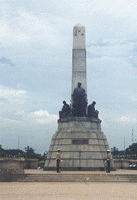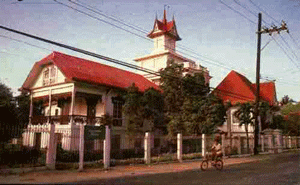Tribung
Pinoy
The
Philippines
Brief
History
Philippine
Government
The
Gateway
Economic
Profile
Arts
& Culture
Indigenous
People
Speak
Filipino
Music
& Song
Photo
Gallery
Important
Links
What's New?
Links to Philippine media
organizations, embassies & consulates,
public and private offices and organizations.
Click here
Philippine Flag
Click here
National Anthem
Click here
|
Discovered by Ferdinand Magellan in 1521 and named after King Philip II of Spain, invaded
by Chinese in 1574, raided by the Dutch in 1646, occupied by the British from 1762 to
1764, a Spanish colony for nearly 400 years, ceded to the United States of America in 1898
and and American possession for almost 50 years, captured by the Japanese in 1942,
liberated by the Americans in 1945 and proclaimed independent on July 4, 1946.
Names of the Philippines at different times in history
In so far as recorded history is concerned, Ma-i
seems to be the earliest name under which the Philippines was
known to the Chinese traders, who were coming here in the tenth
century A.D., attracted by such articles of commerce as yellow wax,
cotton, pearls, tortoise shell, betel nuts, abaca, and so forth. For
these Chinese would barter porcelain, trade gold, iron censers, lead,
colored glass, beads, and iron needles. The natives enjoyed the
reputation of being exceptionally honest in their their business
dealings with the celestials. The name Ma-i was still very
frequently used in the twelfth and thirteenth centuries, and probably
long thereafter.

Rizal monument at Luneta
|
According to
Jose Rizal (national hero), on Ptolemy's map,
which was made before the second century A.D., the group of islands
now known as the Philippines was called Tawalisi.
Ptolemy got his knowledge from a sailor named Hippalus, the same man
who discovered the monsoons in the southeastern Asiatic regions.
In later editions, however, there is group of islands in about the
location of the Philippine group which bears in different editions the
names of Maniolas, Barusas or Baroussai and Puloan or
Palawan. In connection with these different names it is
often stated that they were used in turn to designate the whole
group. But according to Rizal, Baroussai is the Visayas in
Ptolemy's maps. The name Puloan in the edition of 1540 must have
been the name originally borne by the island of Palawan, while
Maniolas, whch is very similar to Maynilad, must have been the name
given to the vast region around Manila.
Magellan, on seeing Samar and the neighboring
islands from the Ladrones on March 16, 1521, gave to the new country
the name of "The Archipelago of San Lazaro," it having been
discovered on the Sabbath of St. Lazarus.
The Archipelago was also called Val Seu
Parigne or Valley Without Peril, in view of the
hospitality and brotherly love shown by the natives to the
discoverers, giving signs of joy because of their arrival, as
distinguished from the hostile attitude under the cover of a seemingly
hospitable but dishonest entertainment received from the people of the
Ladrones Islands.
In Spain, however, the Archipelago, soon
after its discovery by Magellan, became popularly known the Islands
of the West or Islas del Poniente, because
Magellan came here by a westerly route from Spain The
Portuguese, on contrary, called the group the Islands of the
East or Islas del Oriente, because they came
here by an easterly route from Portugal. By the Japanese the
Achipelago was more often called the Luzon Islands, very clearly in
accordance with the name of the island most familiar, because closest,
to them. This form of the name of the island was more frequently
written in other countries as the Luzones or Lucones.
To the south Archipelago was often identified as the Celebes
Archipelago or Islas de Liquios Celebes because
of the Celebes Sea south of Mindanao.
In 1542, Rui Lopez de Villalobos conceived
the beautiful and very appropriate idea of baptizing the Archipelago
with the name Felipinas, or Philipinas, as
recorded by Alvarado, in honor of "our fortunate Prince,"
the man who saved it for Christendom, Rey Felipe II
or King Philip II of Spain. Tis is the name which has been
rendered into English as Philippines. Montero y
Vidal says that the island first to receive the name Filipinas was
Leyte, and the this name was given in July or August of the year 1543
to include some of the smaller islands in the group. Urdaneta
used Las Islas Filipinas as we do now, standing for the
whole Philippine group.
Revolutionary Period
1872. 1892. Two unforgettable years in the history of the
Philippines. The three exemplary priests, Gomez, Burgos and Zamora were executed in 1872
on false charges of involvement in the mutiny of Filipinos in Cavite naval barracks. The
Katipunan was founded by Andres Bonifacio in 1892. Between these two historic years was a
period of 20 years. This was the Propaganda Era, when patriots
dispersed by the troubles in 1872 took up residence in Europe. They had been leaders in
the liberal movement born of the republican regime in Spain.
In 1882 Jose Rizal joined the Filipino propagandists in Spain.
Thus began the brilliant years of the Propaganda Era. In La Solidaridad, Rizal, Marcelo H.
del Pilar, and Graciano Lopez Jaena gave expresion to the aspirations of the Filipino
people. Separatism was, however, still far from their minds.
Rizal wrote Noli Me Tangere and El Filibusterismo to awaken
Spaniards in the peninsula to the events in the Philippines and to point out to his
countrymen their own shortcomings. These two novels inspired Filipinos who even then were
already thinking of revolt. Most of them were sons of the people. One of these was Andres
Bonifacio.
Towards the end of August 1896 the Katipunan was discovered by
the authorities. Bonifacio and his men fled from Manila and assembled in the countryside
just outside the city limits. There they raised the first cry of Philippine independence.
Horrible reprisals were to follow. There were mass arrests, tortures, executions. One of
the victims was Rizal, who had been living peacefully in exile when the Katipunan was
founded. The execution of Rizal redoubled the zeal of the revolution. In numerous battles
with the Spaniards the enemy suffered heavy losses. Reinforcements arrived from Spain, but
the rebellion could not be quelled any longer. The Spaniards agreed to a settlement --
reforms would be granted if the rebels should lay down their arms.
By the terms of the Pact of Biyaknabato the revolutionary leaders
left the country. But the government's promises were not fulfilled. When the
Spanish-American War broke out, Aguinaldo and his fellow exiles returned to the
Philippines and launched the second phase of the Revolution. They had been told, and had
reason to believe, that America would recognize Philippine independence after Spanish
power should have been driven out.
The Filipino army besieged Spanish garrisons. Large numbers of
Spanish troops were taken prisoner. The entire country was soon in revolt. Except for a
few town in the Visayas and Mindanao, the revolutionary government was to hold sway over
the archipelago.
First Republic of the Philippines
 | |
Aguinaldo Shrine in Kawit,
Cavite |
On June 12,
1898, Emilio Aguinaldo proclaimed the independence of the Philippines at a ceremony held
in Kawit, Cavite.
Meantime, the American forces continued to receive reinforcements
for its positions around Manila. Gradually, they occupied lines formerly held by Filipino
troops. What the Filipinos had suspected was about to come true. America had no thought of
ever leaving the Philippines. The first shot announcing the commencement of the
Philippine-American War was expected at any moment.
The Philippine Republic was inaugurated at Malolos on January 23,
1899. Less than a fortnight later, on February 4, the Philippine-American War started.
These events preceded the outbreak of hostilities between
Filipinos and Americans: Spain ceded the Philippines to America although it had already
lost all authority and control over the former colony. In the face of vehement protests
from Filipinos, America went on to annex their country.
To carry out the new colonization of the Philippines, America
poured thousands upon thousands of troops into its all-out campaign to "get
Aguinaldo." The Filipino army was broken up, only to reorganize for guerrilla
warfare. Aguinaldo was taken on March 23, 1901. One by one, other Filipino generals
were taken prisoner. After the surrender of General Malvar on April 16, 1902, the war
officially declared ended. Those who continued to fight were henceforth outlawed and
treated as brigands.
Succeeding years witnessed a resurgence in Filipino nationalist
literature and drama. Not a few dramatists were arrested, fined, or imprisoned for staging
nationalist and anti-American zarzuelas. The agitation for independence rose to new
heights, although now under altered circumstances. Within a few years would come Filipino
participation in the government. The independence movement, along peaceful lines, would be
organized not long after. The Philippine Assembly was inaugurated in 1907. The Philippine
Commission, the upper house, still had American members, however. An all-Filipino
legislature was introduced in 1916 under the Jones Law. Under the leadership of Senate
President Quezon and Speaker Osmena, the independence campaign received nation-wide
sanction and active support, until finally it culminated in the establishment of the
semi-independent Commonwealth.
The Japanese Occupation Year (1942 to 1945) brought the Japanese
sponsored Philippine Independence on October 14, 1942 and Japan's "Greater East Asia
Co-Prosperity Sphere." The KALIBAPI -- "Kapisanan sa Paglilingkod sa Bagong
Pilipinas" -- acted as the Preparatory Commission for Philippine Independence.
Filipino ingenuity and resilience were displayed in planting
programs, trading, and mechanical inventions. The resistance movement ambushed the enemy,
conducted intelligence work, and liquidated Japanese spies and collaborators.
The United States
granted Filipinos independence in 1946. The democratic traditions were upheld by
successive presidents (Quezon, Roxas, Quirino, Garcia, Macapagal) until Ferdinand Marcos
imposed martial law in 1972. The Marcos authoritarian rule toppled after the
"People Power" in 1986 restored democracy and freedom.
The government, led by Corazon Aquino restored the Philippine
Congress and the two-party political system.
Corazon C. Aquino was succeeded by his
former defense secretary when people voted Fidel V. Ramos as president of the Philippines.
The presidential electorate, voted former actor, San Juan mayor and Senator Joseph
Ejercito Estrada as president of the Republic. He took his oath of office at the
historical Barasoain Church in Malolos, Bulacan where the First Congress of
the Philippines was held.
A bloodless revolution ousted President Estrada for
corruptions. He was succeeded by his vice-president, Gloria Macapagal-Arroyo,
daughter of the late President Diosdado Macapagal. She instituted government
economic reform, massive housing, agricultural productions, crime busting and fight
against terrorism.
|